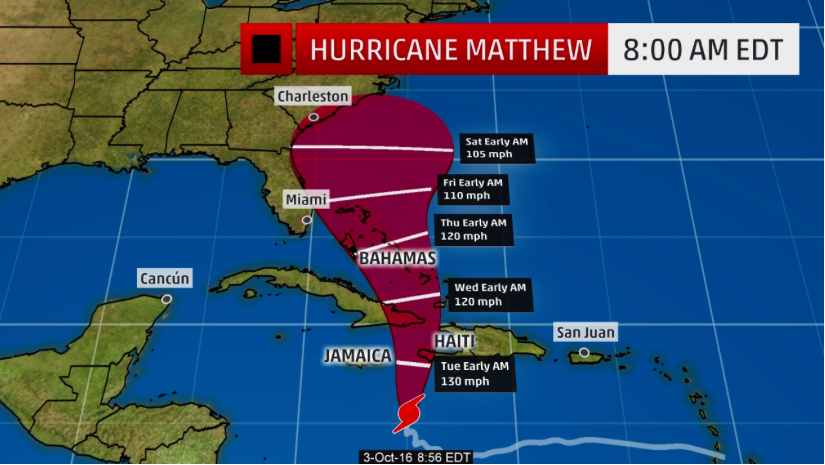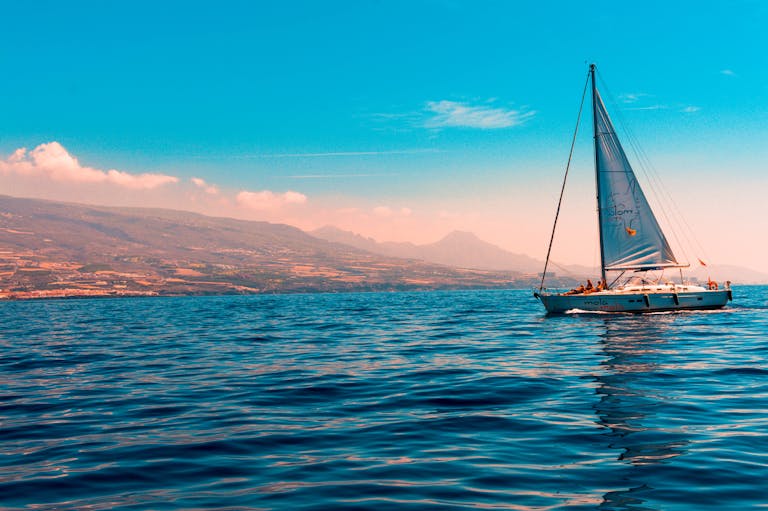Fear is what I feel. I’m scared. My husband, Simon, is also scared although he doesn’t admit it as much as I do. Hurricane Matthew is less than a week away and reports predict a path heading up the east coast of America. Our home, a 56’ sailboat named Britican is currently docked at a marina in Charleston, South Carolina with a clear view of the Atlantic Ocean. Protected by land, we are not.
Currently Matthew is a Category 5 hurricane with 140mph winds heading north in the Caribbean.

Chances are that the hurricane will lose strength but based on latest reports we’re expecting possible 90mhp winds by the time he reaches us.
Tropical storm Hermine, a hurricane that eventually downgraded to a tropical storm, hit us last month with winds topping out around 50 to 60mph (Check out the article and video, Preparing our boat for a hurricane for our first tropical storm experience). There was wind, rain a tiny bit of thunder and lightening. On a few occasions we had to adjust a line or push a popped up fender back between the boat and the dock. Overall, however, the conditions weren’t too bad. Some boats had minor damage, but what frightened me was the destruction of parts of Pontoon A at the marina (we’re on Pontoon B). If the marina starts to break up, what control as boat owners do we have?
Surely people with homes get nervous when the report of a potentially destructive hurricane is on its way.
Homeowners, however, have no choice about what to do other than, ‘do we stay at the house,’ or ‘do we evacuate.’ If the forecast is looking particularly grim, government or state led officials will enforce a full evacuation anyway.
For a boat owner, however, we have choices. We can move our house. We can choose to stay in a marina, have the boat hulled out and put on land, set sail to potentially get out of the hurricane’s path or we can find a river, head inland as much as possible and anchor the boat. No matter what we do, we’ll be praying. If we choose to anchor, we then have to choose whether to stay on the boat or get off. With little certainty about anything, we have some potentially difficult decisions to make.
If the hurricane is above a Category 1, it’s highly likely that our marina will not survive.
Our boat is tied to a floating finger pontoon. The pontoons are floating cement structures anchored to the sea floor by more cement and thick chains. With enough disturbances, the chains will break, the docks will separate and the marina will essentially float away.
- How to build a website with WordPress and what are the best plugins to use: Building a website with WordPress is an excellent choice due to its versatility, ease of use, and a vast array of plugins that enhance functionality. Here’s a comprehensive guide to building a WordPress website, along with recommendations for the best plugins.
- What does this property buzzword mean and how does it actually work? Gearing simply means borrowing money to buy an asset. Negative gearing can be a tax strategy used by investors and describes when the income (ie, the rent) made from an investment is less than the expenses it incurs, meaning it’s making a loss.
- How to Sell Your Ecommerce Business for the Best Value: Selling an ecommerce business can be a very profitable move. You can use the proceeds to invest in other projects, launch new ecommerce business websites, or even retire. For some startups, selling the business is the end goal. Whether you have a dropshipping website, sell with Amazon FBA, or own a large-scale ecommerce business, there’s an opportunity for you to sell.
- Comprehensive Guide to WordPress Website Development: Developing a WordPress website is a sequential process that requires careful planning, thoughtful execution, and consistent maintenance to ensure it meets the needs of users and achieves its intended goals. This involves a series of clearly defined stages, including planning, designing, content creation, optimisation, and ongoing maintenance.
- Top 10 High-Paying Jobs AI Won’t Replace in 2025: Artificial Intelligence (AI) is revolutionizing industries, automating repetitive tasks, and reshaping the global workforce. Despite its remarkable advancements, certain professions remain beyond AI’s capabilities due to their reliance on uniquely human traits like creativity, empathy, and critical thinking. This case study explores the 10 highest-paying, fastest-growing jobs in 2025 that AI won’t replace, delving into why these roles are indispensable and how they are evolving in an AI-driven world.
- Spill Your Guts: What To Wear To Olivia Rodrigo’s Australian Tour: Never afraid of screaming out all the dark, embarrassing things we’ve all thought before, Rodrigo sings about comparing herself to her boyfriend’s ex-girlfriend. If you want an edgy outfit that mimics the music…
- Top Social Media Plugins for WordPress to Increase Your Sites Reach and Engagement: If you are seeking to enhance your website’s reach and engagement on social media, you have come to the right place. In this article, we will delve into the premier social media plugins tailored for WordPress users. From Social Warfare to Jetpack, these plugins can facilitate seamless sharing of your content across diverse social platforms.Furthermore, we will provide recommendations to optimize your website’s visibility on social media. Keep an eye out for valuable insights!
- How to Change PuTTY’s Appearance: PuTTY is a widely-used SSH and telnet client for Windows and Linux hosting. While its default appearance is functional, you can customise it to improve aesthetics and usability. Below are the steps to modify PuTTY’s appearance, including changing the font, window size, colours, and cursor options.
- What programming languages does vBulletin use?: vBulletin was orginally written in perl and used a flat file database system. However, as sites grew they notice that sites could not cope with a large amounts of traffic. This problem has now been fully rectified when vBulletin was converted to php and a mysql database system.
Our best bet, while surveying the situation based on today’s weather report, is to start considering a trip up the Cooper River. As long as the depth is enough to accommodate our 7.5’ draft (depth that the keel of the boat sits below the water), we can travel up the river, navigate through as many bends as possible and find a cove that allows for a 360 swing. With the cyclical nature of hurricanes, once anchored we’ll have to assume that the storm will potentially have wind hitting us from all directions eventually; we’ll need to be able to completely swing on our anchor without touching bottom.
But once we anchor, do we stay with the boat?
I suppose there has to come a point when the forecast either predicts weather that warrants an evacuation or it doesn’t. If we need to leave the boat, we’ll do so by using our tender…but where do we go? And what do we do with our tender and outboard?
I think the issue I’m struggling with most is that I’d rather stay in the marina where I feel ‘safe’ amongst other boats. However, if the forecast is correct I have high doubts about the structural integrity of these floating pontoons. Our neighbor, Ron, a seasoned live aboard, has been extremely helpful with discussions on various options. He’s lived through hurricanes – he knows the drill. I’m thankful and grateful that we have someone with wisdom nearby…but of course…
…I don’t know what I don’t know and that freaks me out.
If we motor up river, what if we can’t find a place to spin on our anchor? What if it’s too shallow? What if conditions get bad and I have to take our daughter to a safe location…and Simon requests to stay on board alone? What if the boat ends up 20 miles on land in someone’s living room? What if…?
Throughout our five-year sailing history, of which 2 ½ years have been full time, we’ve encountered a variety of storms. Heck, we’ve sailed through three Force 10 storms (to put that in context, I think Force 12 is hurricane – Force 10 is bad) and have experienced waterspouts, lightening and thunder, hail and torrential downpours. At marina’s, we’ve worked hard to protect our boat when major storms hit…Once, one of the cleats from the dock pulled right out. We quickly managed to use another cleat and no damage occurred.
We’ve lived through storms. We’ve got that t-shirt. When forced to endure a storm we have the confidence to know we’ll most likely survive. What we haven’t lived through, however, is a full blown hurricane. And frankly, I don’t feel the need to gain that experience now or ever.


